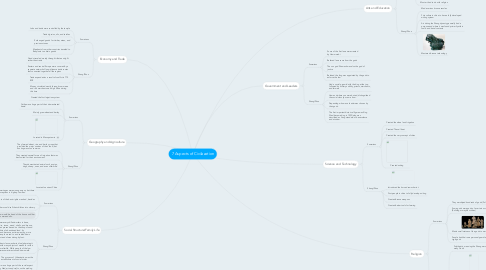
1. Economy and Trade
1.1. Sumerians
1.1.1. Jobs and trade were controlled by the temple
1.1.2. Traded grains, oils, and textiles
1.1.3. Exchanged goods for timber, wines, and precious stones
1.1.4. Merchants from other countries traveled to Babylonia to obtain goods
1.2. Shang/Zhou
1.2.1. Goods traveled mostly through tribute and gift rather than trade
1.2.2. Eastern and central Europe were covered by a separate network of long-distance trade routes that connected together all the regions
1.2.3. Trade expanded as a result of conflict in 770 BCE
1.2.4. Money circulated mostly through commerce and rich merchants won high office during this time
2. Social Structure/Family Life
2.1. Sumerians
2.1.1. Most marriages were monogamous, but there were exceptions in high-up families.
2.1.2. Had most of the basic rights men had, besides divorce
2.1.3. Fathers could sell their children into slavery
2.1.4. A widow would be head of the house until her children were adults.
2.2. Shang/Zhou
2.2.1. The Shang were very skilled workers in bone, jade, ceramics, stone, wood, shells, and bronze. This has been proven based on the shops found on the outskirts of abandoned land. Its evacuated land because as time went by, more and more people moved to and settled down on farms, instead of wandering by foot.
2.2.2. The highest class was buried in elaborate pit tombs with many objects of wealth for with a hope for afterlife. While people of the low class were sometimes tossed down wells.
2.2.3. The process of Urbanization was the establishment of social order.
2.2.4. Mechanism was a huge part of the social aspect of life. They liked arts and crafts, so the making of bronze brought together the community.
3. Geography and Agriculture
3.1. Sumerians
3.1.1. Created the first Irrigation system
3.1.2. Cattle was a huge part of their domesticated heard
3.1.3. Mainly grew wheat and barley
3.1.4. Located in Mesopotamia
3.2. Shang/Zhou
3.2.1. They farmed wheat, rice, and barley crops that provided the major sources of their food, but hunting wasn't uncommon.
3.2.2. They created several forms of irrigation that was best suited for their environment.
3.2.3. They domesticated animal such as pigs, dogs, sheep, oxen, and even silkworms.
3.2.4. Located in ancient China
4. Arts and Education
4.1. Sumerians
4.1.1. Sumerians had very advanced architecture
4.1.2. Made huge statues
4.1.3. Had a wide range of literature
4.1.4. Most art had to do with religion
4.2. Shang/Zhou
4.2.1. Made various bronze vessles
4.2.2. First culture in china to have a fully developed writing system
4.2.3. Art during the Shang dynasty generally had a purpose and where it was found primarily within tomb and burial contexts
4.2.4. Mastered bronze technology
5. Science and Technology
5.1. Sumerians
5.1.1. Created the wheel and irrigation
5.1.2. Created The sail boat
5.1.3. Created the very concept of cities
5.1.4. Created writing
5.2. Shang/Zhou
5.2.1. Introduced the horse drawn chariot
5.2.2. First people in china to fully develop writing
5.2.3. Created bronze weapons
5.2.4. Created better tools for farming
6. Government and Leaders
6.1. Sumerians
6.1.1. Some of the first laws were created by Hammurabi
6.1.2. Believed laws came from the gods
6.1.3. The sun god Shamash was also the god of justice
6.1.4. Beleived the king was appointed by the gods to enforce the law
6.2. Shang/Zhou
6.2.1. Had a social pyramid with the king at the top followed by military nobility, priests, merchants, and farmers
6.2.2. How and where you were buried, distinguished the social class you came from.
6.2.3. Depending who was a leader was chosen by their gods.
6.2.4. The first important historical figure was King Wen (became king in 1099) who was described as living standard of benevolence and wisdom.
7. Religion
7.1. Sumerians
7.1.1. They worshiped hundreds of gods (Polytheism)
7.1.2. Some gods were gods of a certain occupation. (Building or maybe scribes)
7.1.3. Made small statues of the gods to worship with
7.1.4. People had their own personal guardian-angel type gods
7.2. Shang/Zhou
7.2.1. Polytheistic, meaning the Shang worshiped many Gods
7.2.2. Worshiped their ancestors. They did this because they thought the health of the people and crops was based on the happiness of their ancestors.
7.2.3. Greed tradgedies would occur if the ancestors were not pleased
7.2.4. The Shang Dynasty was Shang Ti, People had to please him by prayers, offerings, and sometimes human sacrifices.

